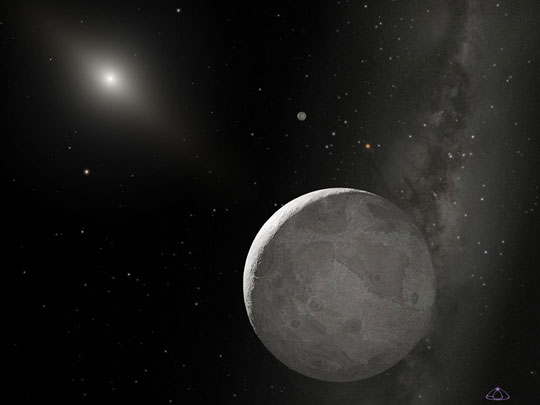The first decade of the 21st century has received outstanding scientific achievements, many of which have changed or shaken our inherent insights into a number of scientific areas. Please summarize the 10 most significant scientific findings.
Scientific findings of the decade
The body of Eris joined the solar system

In 2005, Mike Brown and his team at Palomar Observatory, California, discovered 136199 Eris - an object about 27% larger than the size of Pluto, so Eris passed. Pluto to become the 9th largest celestial body orbiting the sun. The consequence of this discovery is that in 2006 Pluto was demoted to a dwarf planet and had to carry a sequence of numbers before his name - 134340 Pluto.
Found soft tissue sections from dinosaur fossils

Also in 2005, Mary Higby Schweitzer and colleagues discovered soft tissue in a fossil femoral fossil. These tissues include blood vessels, basic bone-forming substances, and other cells. From this discovery, scientists have found amino acids that are similar to the amino acids of modern chickens, thereby reinforcing the relationship between dinosaurs and birds.
Affirm the existence of black matter

In 2006, scientists finally found the first evidence that the existence of ' black matter ' - the kind of invisible material that has long been viewed as a binding agent for galaxies and solutions. like the weight distribution in the whole universe. This result is drawn after the study of the collision between 2 galaxies 100 million years ago.
Discover some more ancestors of humanity

So far, we still think that the oldest prehistoric fossil, Lucy, was discovered in 1974, dating back 3.3 million years. But in 2007, French archaeologists unearthed a skull about 6-7 million years old of the Toumai species - believed to be the oldest ancestor of humankind.
Later, in 2009, American scientists announced the discovery of another fossil skeleton named Ardi, which is 4.4 million years old. From the findings, scientists believe that it is quite possible that humans and the species of monkeys that exist on Earth have the same ancestors, not the successive links in evolution.
Direct observation of planets outside the Solar System

During the past 15 years, scientists have been very successful in 'hunting ' non-solar planets, and now on their list there are about 450 ' extraterrestrials'.
Some astronomers argue that this is positive evidence in the universe that there are many planets and possibly many of our planet-like planets.
Robot - human machine

The past decade has also seen many achievements in combining human activities with machines and vice versa. In 2000, a team of Duke University Medical Center scientists connected electrodes to monkeys' brains and trained them to manipulate robotic arms to pick up food. In 2009, Pierpaolo, Petruzziello - who was amputated with an arm - became the first person to control the robot arm by thinking through wires and electrodes connected from the rest of the arm to a mechanical robot arm - biological. This study may help restore motor function in patients with polio.
Stem cell development from many other sources

In 2007, US and Japanese scientists announced the successful development of stem cells from human skin. A month later, a group of other US scientists said it had taken a new step when it created stem cells with a specific gene code of the patient, which could eliminate the risk of the patient's body eliminating tissue. or transplanted organs. These works were considered the greatest medical achievements in 2007. Stem cells are considered the " savior " of humans in the fight against incurable diseases like cancer, cardiovascular disease, diabetes. Paralysis, dementia, spinal cord injury, stroke . because it can develop into any of 220 types of cells in the human body.
Detecting signs of water on the surface of Mars

During the last decade of research, scientists have gained quite a bit of scientific evidence that water exists on the red planet. The signs of erosion on the planet's surface are the most convincing evidence of weather changes and the existence of the planet's past liquid water.
There is still a question: Is there still a source of water on Mars? In the near future, research ships with NASA gamma ray spectroscopes will land on Mars. It can measure the signal of hydrogen in the water. Perhaps then, scientists will have the correct answer.
Mapping human genes

The Human Genome Mapping Project is an international scientific research project that started in 1990. The main purpose of the project is to determine the sequence of base pairs that form DNA molecules and identify about 25,000 genes in the human genome. The first draft of the genome was born in 2000 and completed in 2003. Any individual's genome (except for twins and duplicates) is unique.
With this genetic map, science has a new tool to delve into the most fundamental biological problems of humans, especially the monitoring of genetic factors related to diseases such as cancer, Alzheimer's, Parkinson's, high cholesterol, autism, mental retardation .
Glaciers narrowed with worrying speed

The annual average melting rate of glaciers in the world has doubled when humanity entered the 21st century. Climate change is the main cause of this situation. Its consequences have been seriously affecting the environment and human life, the most obvious manifestation is the rising sea levels throughout the planet, engulfing homes of hundreds of millions of people, narrowing the area of cultivation and livestock, threatening the supply of food, energy and water.










 'Fine laughs' - Scary and painful torture in ancient times
'Fine laughs' - Scary and painful torture in ancient times The sequence of numbers 142857 of the Egyptian pyramids is known as the strangest number in the world - Why?
The sequence of numbers 142857 of the Egyptian pyramids is known as the strangest number in the world - Why? History of the iron
History of the iron What is alum?
What is alum?